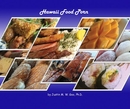My Aunty makes the best pho in the world, better than any restaurant pho could ever be. But really, what she's using to make it isn't pho noodles, but Chinese ho fun noodles. Ho Fun is essentially what you stir fry to make chow funn. And where does she get these fresh, handmade noodles, but in Chinatown, from places like Ying Leong or Yat Tung noodle factories. Because they are fresh and never dried, the texture is just perfect. As a rice noodle, it's much softer than say egg noodles or wheat noodles. In her broth, they are (as Chinese would say) so slippery, which makes them perfect for slurping up with soup. Because there is so much crossover in cuisine, it is not surprising that Vietnamese food should taste kinda familiar.
While they are similar, Vietnamese versions of Chinese dishes are always herbier, more aromatic, and more intensely flavored. Vietnamese cooking in general has probably the most complex combination of distinct flavors of any cuisine. Even Indian food, which uses several dozen spices for every dish, usually has the spices blend together. But in Vietnamese food, the various fresh herbs, like basil, lemongrass, mint, and Chinese parsley, and the other ingredients are always kept distinct, so ther flavors really play off one another. It is almost the opposite of Japanese cuisine, which uses stark simplicity to draw out singular ideal flavor. So even though you can go to a Vietnamese restaurant and find familiar Chinese things like, spring rolls and won ton mein, they always taste pretty different.
Duck Leg Noodle at Golden River Restaurant
Probably my favorite Vietnamese interpretation of a Chinese dish, is ngap tui mein (or stewed duck leg noodle). My favorite place to get it was a restaurant called Ho Bien (which literally just means "by the river"). It was on the very edge of Chinatown, right on the corner of River St. and King (across from Nuuanu Stream). I have been going to Ho Bien since I was in high school. It was one of the first Vietnamese restaurants I really liked, and eating ngap tui mein there was like dipping my feet into the shallow end of the pool. I could even speak Cantonese to the staff there. It has since changed owners, and is now called Golden River Restaurant, but the food is still basically the same. As soon as it is served, their ngap tui mein hits you with the scent of star anise, and mushrooms, and almost a cinammon like spice. The duck, is fork tender, and obviously has been stewed for enough time that the broth has just been infused with intense duck flavor. It is the intensity of these spices and duck flavor that separates it from its Chinese counterpart.
Mixed Drink at Golden River Restaurant
After eating any broth at Golden River, it really needs to be followed by one of their fantastic desert drinks. My favorite is the "mixed drink", again a mixing of familiar and not so familiar flavors in complex combination. Let's see... Coconut milk, very familiar (to anyone who's eaten haupia). Azuki Beans, very familiar (to anyone whose ever eaten mochi or shave ice). Pomegranate seeds, not so familiar around here, but they're crunchy and mild tasting. Translucent red and green noodles, uh.... not so familiar, but they're like long rice only firmer, kind of odd to be eating them in a drink though. Mung beans, very distinctly Vietnamese, used in a lot of their cooking, and leads a very thick smooth texture to the concoction. Separated, it is just a thing of beauty. Look at the colors! The colors!! But once it's stirred and mixed together, the combination of all of these flavors and textures playing off of each other is just a barrage of sweet goodness in your mouth.
Do the Vietnamese interpretations outclass their Chinese counterparts, certainly not. But they are a wonderful variation, making the familiar into something exotic and enticing. To put it simply, "sometimes you feel like a nut... sometimes you don't..."





Vietnamese food is also generally a lot healthier than Chinese food. So, "sometimes you feel like fat, and sometimes you don't".
ReplyDeleteAnd it still baffles me how Vietnamese food is one of the world's healthiest cuisines, when it essentially combines two of the most un-healthiest cuisines: French (Fat and butter-laden) and Chinese(Fat and oil-laden).